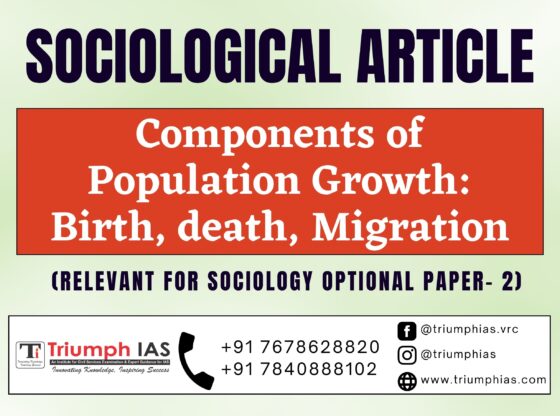Components of Population Growth: Birth, death, Migration
Relevant for sociology optional Paper- 2 (Unit- 13 : Social Changes in India)

Population growth refers to the increase in the number of individuals living in a particular area over a given period. In general, population growth is influenced by three major factors: birth, death, and migration. These three components of population growth have significant implications for economic, social, and political development. In this essay, we will examine these components of population growth in India, with a particular focus on their impact on the country’s development.
Birth: Birth is the primary component of population growth and refers to the number of live births in a particular area over a given period. In India, birth rates have been declining in recent years due to several factors, including increased access to education, improved healthcare, and the availability of family planning services. According to the World Bank, India’s birth rate was 18.2 births per 1,000 population in 2020, down from 20.4 births per 1,000 population in 2010.
However, despite the decline in birth rates, India continues to have a high fertility rate, with an average of 2.2 children per woman in 2020. This high fertility rate is due in part to cultural and social factors, such as the desire for large families and the preference for male children. India also has a significant population of young people, which contributes to high birth rates.
The high birth rate in India has several implications for the country’s development. First, it puts pressure on the government to provide essential services such as healthcare, education, and employment. Second, it can lead to a youth bulge, where a large proportion of the population is young and unemployed, leading to social and political instability. Finally, it can exacerbate environmental problems such as deforestation and pollution.
Death: The death rate is the number of deaths in a particular area over a given period. In India, the death rate has been declining in recent years due to several factors, including improved healthcare, increased access to education, and better living conditions. According to the World Bank, India’s death rate was 6.3 deaths per 1,000 population in 2020, down from 7.4 deaths per 1,000 population in 2010.
However, despite the decline in the death rate, India continues to face several challenges in the healthcare sector, including inadequate healthcare infrastructure, a shortage of medical personnel, and a lack of funding. India also has a high burden of communicable diseases such as tuberculosis and malaria, which contribute to the high death rate.
The high death rate in India has several implications for the country’s development. First, it can lead to a decrease in the population growth rate, which can have economic implications. Second, it puts pressure on the government to provide better healthcare services and infrastructure. Finally, it can lead to a decrease in the quality of life for individuals and communities.
Migration: Migration refers to the movement of people from one area to another. In India, both internal and international migration play a significant role in population growth. According to the 2011 Census, there were approximately 450 million internal migrants in India, with the majority of these migrants moving for work or education.
International migration is also an essential component of population growth in India. According to the Ministry of External Affairs, there were approximately 17.5 million Indian nationals living abroad in 2020, with the majority of these migrants living in the United Arab Emirates, the United States, and Saudi Arabia.
Migration has several implications for India’s development. First, internal migration can contribute to urbanization and economic growth, as migrants move to cities in search of work and better living conditions. However, it can also lead to social and political tensions, as migrants may face discrimination and marginalization. Second, international migration can have economic implications, as remittances from Indian nationals living abroad contribute significantly to the country’s economy. However, it can also lead to brain drain, where highly skilled individuals leave the country for better opportunities abroad, resulting in a loss of talent and expertise in key sectors of the economy. Additionally, international migration can have social implications, as families may be separated for extended periods, leading to emotional and psychological stress. Finally, migration can also contribute to environmental problems, as migrants may settle in ecologically sensitive areas, leading to deforestation, soil erosion, and pollution.
In conclusion, birth, death, and migration are the three primary components of population growth in India. Each of these components has significant implications for the country’s development, including economic, social, and environmental implications. While India has made progress in reducing birth and death rates, there are still several challenges that need to be addressed, including improving healthcare infrastructure, reducing poverty and inequality, and promoting sustainable development. Additionally, migration continues to play a significant role in India’s population growth, and policies and programs need to be developed to ensure that the benefits of migration are maximized while minimizing its negative impacts.
For more such free UPSC notes, Articles, News & Views Join our Telegram Channel. https://t.me/triumphias
Click the link below to see the details about the UPSC – Civils courses offered by Triumph IAS. https://triumphias.com/pages-all-courses.php


